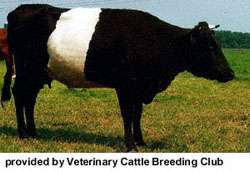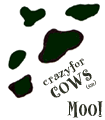|
|
|
|
|
|
|
Breed: Dutch Belted:
- The Dutch Belted's history is a bit unclear before the 1600s. A few records and
paintings show belted cows grazing on the estates of Dutch nobility before this time.
- Early belted cows were crossed with other breeds, like the Holstein.
- The breed began to flourish in Holland in the 1750s.
- The Dutch were very protective of their belted cattle and did not encourage their export.
- The Dutch Belted were imported into the United States in the 1830s, and the breed
become purebred in order to preserve the distinctive characteristics.
- The herdbook was established in the US in 1886.
- In Holland the breed has been diluted by cross-breeding. Now the US breed is the most purebred
in the world, and it is being used to improve the Holland breed.
- Dutch Belted cows are noted for their easy calving, easy handling, and docile, friendly nature.
They have unusual longevity.
- They are good for pasture-based farms (where the cows eat more grass than grain).
- According to the breed standard, a Dutch Belted has a belt that is at least 6 inches wide making
a complete belt around the body.
- The belt occurs behind the withers and before the rump.
- The udder is usually white.
- The average Dutch Belted cow is just over 4 feet high at the withers, the average bull, just
under 4 1/2 feet.
- The average cow weighs about 930 pounds, the average bull, about 1,980 pounds.
- The Dutch Belted is considered a critically rare breed; there are only about 200 registered
Dutch Belted cattle in the United States.
- There are other breeds that have belted cows, like the Galloway, Welsh Black, and Swiss Brown.

Sources:
A Field Guide to Cows, by John Pukite, Falcon Press, Helena, Montana, 1996, pp. 20-21.
and
OSU's Breeds of Livestock
-- Dutch Belted Cattle page.
|
|



